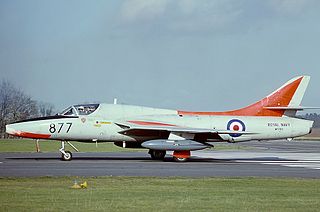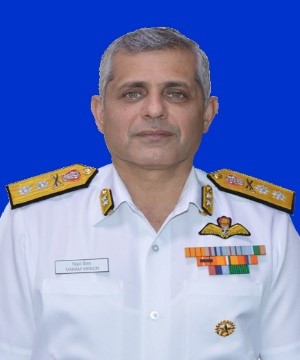| INAS 300 | |
|---|---|
| Active | 7 July 1960 - Present [1] |
| Country | |
| Branch | |
| Garrison/HQ | INS Hansa |
| Nickname(s) | The White Tigers [2] |
| Aircraft flown | |
| Fighter |
|
The INAS 300 is the longest serving combat unit of the Indian Navy, [5] based at INS Hansa. [2] [3]
| INAS 300 | |
|---|---|
| Active | 7 July 1960 - Present [1] |
| Country | |
| Branch | |
| Garrison/HQ | INS Hansa |
| Nickname(s) | The White Tigers [2] |
| Aircraft flown | |
| Fighter |
|
The INAS 300 is the longest serving combat unit of the Indian Navy, [5] based at INS Hansa. [2] [3]
The White Tigers were commissioned on 7 July 1959 [5] at RNAS Brawdy, United Kingdom with the Indian High Commissioner to UK, Vijay Laxmi Pandit, in attendance. The first Squadron Commander was Lt Cdr B D Law. The squadron was initially equipped with the Hawker Sea Hawk aircraft. On 18 May 1961, Lt Cdr R. H. Tahiliani carried out the first deck landing on INS Vikrant on Sea Hawk IN 156. The squadron left RNAS Brawdy on 31 July 1961 with eleven Hawker Sea Hawks and embarked INS Vikrant off the Isle of Wight. During the course of the next ten years the Indian Navy inducted fifty-four Sea Hawks in a phased manner, the last aircraft being delivered in December 1971. [6] The Sea Hawks were retired from the Indian Navy in a phased manner in the late-70s and early-80s. [5] The Sea Harriers were replaced by MiG-29KUBs on 11 May 2016 in a ceremony held at INS Hansa. They now act as an operational conversion unit for the INAS 303, the black panthers. [4]

INSVikrant was a Majestic-class aircraft carrier of the Indian Navy. The ship was laid down as HMS Hercules for the British Royal Navy during World War II, but was put on hold when the war ended. India purchased the incomplete carrier in 1957, and construction was completed in 1961. Vikrant was commissioned as the first aircraft carrier of the Indian Navy and played a key role in enforcing the naval blockade of East Pakistan during the Indo-Pakistani War of 1971.

The British Aerospace Sea Harrier is a naval short take-off and vertical landing/vertical take-off and landing jet fighter, reconnaissance and attack aircraft. It is the second member of the Harrier family developed. It first entered service with the Royal Navy in April 1980 as the Sea Harrier FRS1 and became informally known as the "Shar". Unusual in an era in which most naval and land-based air superiority fighters were large and supersonic, the principal role of the subsonic Sea Harrier was to provide air defence for Royal Navy task groups centred around the aircraft carriers.

Royal Air Force Brawdy, or more simply RAF Brawdy, is a former Royal Air Force satellite station located 6.3 miles (10.1 km) east of St Davids, Pembrokeshire and 9.8 miles (15.8 km) south west of Fishguard, Pembrokeshire, Wales. It was operational between 1944 and 1992; it was used by the Royal Air Force and the Royal Navy (1946–1971), before the site was turned over to the British Army and renamed Cawdor Barracks.

800 Naval Air Squadron was a Royal Navy Fleet Air Arm carrier-based squadron formed on 3 April 1933 by amalgamating No's 402 and 404 Flights.
The Indian Naval Air Arm is the aviation branch and a fighting arm of the Indian Navy which is tasked to provide an aircraft carrier based strike capability, fleet air defence, maritime reconnaissance, and anti-submarine warfare.

Sagar Pawan is the aerobatic demonstration team of the Indian Navy's Aviation Arm. It is one of the only two naval aerobatic teams in the world, the other being the Blue Angels of the US Navy.

Admiral Arun Prakash, PVSM, AVSM, VrC, VSM is a former Flag Officer of the Indian Navy. He served as the Chief of the Naval Staff from 31 July 2004 to 31 October 2006 and as the Chairman of the Chiefs of Staff Committee from 31 January 2005 to 31 October 2006. He is one of India's most decorated naval officers.
801 Naval Air Squadron (NAS) was a Fleet Air Arm squadron of the Royal Navy formed in 1933 which fought in World War II, the Korean War and the Falklands War.

736 Naval Air Squadron was a Naval Air Squadron of the Royal Navy. It was most recently recommissioned at RNAS Culdrose on 6 June 2013 to fly the BAE Systems Hawk T1, following the disbandment of the Fleet Requirements and Aircraft Direction Unit (FRADU) and operated up until March 2022.

INS Hansa, is an Indian naval air station located near Dabolim in Goa, India. It is India's biggest naval airbase. The military air base has a civil enclave, that operates as Dabolim Airport.
899 Naval Air Squadron was a squadron of the Fleet Air Arm of the United Kingdom.
The INAS 312 is an Indian naval air squadron based at INS Rajali.
The INAS 551 is an Indian naval air squadron based at INS Dega, Visakhapatnam.
738 Naval Air Squadron was a Naval Air Squadron of the Royal Navy's Fleet Air Arm. It was initially active from 1943 to 1945 as a training squadron for USA aircraft types used by the Fleet Air Arm. Reformed in 1950, it continued to form part of the Fleet Air Arm training programme until its last disbandment in 1970.

759 Naval Air Squadron was a Naval Air Squadron of the Royal Navy's Fleet Air Arm. It was created on November 1st, 1939 and was disbanded on December 24, 1969. It was initially intended as a Telegraphist Air Gunner Training Squadron but became a Fighter School and Pool Squadron in 1939, at RNAS Eastleigh. It operated out of RNAS Yeovilton from 1940 to 1946, as part of the Naval Air Fighter School. In 1943 a detachment operated out of RNAS Angle, working with 794 NAS and known as the Naval Air Firing Unit. It was again the Naval Air Fighter School upon reformation in 1951 and disbandment in 1954, firstly at RNAS Culdrose and then moving to RNAS Lossiemouth, in 1953. The squadron reformed again, this time at RNAS Brawdy in 1963, as the Naval Advanced Flying Training School, before finally disbanding in 1969.

764 Naval Air Squadron was a Naval Air Squadron of the Royal Navy's Fleet Air Arm. It initially formed in April 1940, at RNAS Lee-on-Solent, as an Advance Seaplane training Squadron. The Squadron moved to RAF Pembroke Dock in July 1940, and later to RNAS Lawrenny Ferry, in October 1941 and remaining there until the Squadron disbanded in November 1943. It reformed at RNAS Gosport, in February 1944, as the User Trials Unit, however, the Squadron was decommissioned for the second time in September 1945. 764 NAS reformed again, at RNAS Lossiemouth, in May 1953, where it became an Advanced Training Unit. It moved to RNAS Yeovilton in September 1953, where it received its first jet aircraft. In November 1954 the Squadron disbanded.

767 Naval Air Squadron was a Naval Air Squadron of the Royal Navy's Fleet Air Arm. It was initially formed as a Deck Landing Squadron in 1939, when 811 Naval Air Squadron was renumbered 767 NAS, at RNAS Donibristle. A detachment went to Hyeres de la Palyvestre in the south of France, enabling training in fairer conditions. While here, the squadron took on an operational mission, with a bombing attack on the Italian port of Genoa. With the fall of France the squadron evacuated to Algeria, where it split. Part went to Malta, forming 830 Naval Air Squadron, the other part to HMS Ark Royal, with personnel returning to the UK via Gibraltar. The squadron regrouped at RNAS Arbroath and moved to the Deck Landing School at RNAS East Haven in 1943.
Vice Admiral Kankipati Appala Satyanarayana Zagapathi 'KASZ' Raju, PVSM, AVSM, NM is a former Flag officer in the Indian Navy. He last served as the Flag Officer Commanding-in-Chief Western Naval Command, from 1992 to 1994. A naval aviator, he was part of the Navy's first naval air squadron INAS 300 and was embarked on the Navy's first aircraft carrier INS Vikrant. During the Indo-Pakistani War of 1971, he was the executive officer of the Leopard-class frigate INS Brahmaputra (1957), for which he was awarded the Nao Sena Medal. He later commanded the Western Fleet and the Southern Naval Command.

Rear Admiral Vikram Menon, VSM is a serving flag officer of the Indian Navy. He currently serves as the Joint Secretary at the Department of Military Affairs. He previously served as the Flag Officer Naval Aviation (FONA) and Flag Officer Goa Naval Area (FOGA), and as the Assistant Chief of Naval Staff (Air) at Naval headquarters.